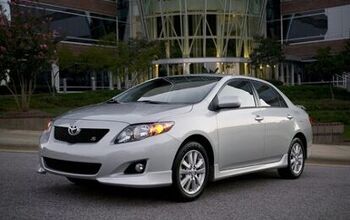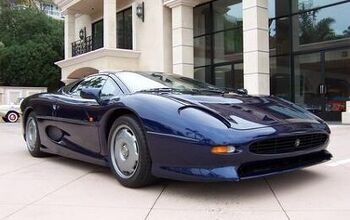Highlight and Delete
If The Big Three are really serious about paring their production costs to the bone, it's time for them to take a good hard look at the basics. Some of the "standard" features on today's automobiles are either unnecessary or antiquated. While removing or re-engineering these items may sound like a trivial pursuit, American automakers simply can't to afford to ignore the potential savings. They should be ready, willing and able to click, drag, highlight and delete.
Very few motorists regularly check their engine oil. Even fewer monitor their oil pressure gauge, or have the slightest idea what it indicates (much less whether or not the needle is pointing to a safe or a dangerous position). Even if a driver happened to be staring at the oil gauge when a catastrophic loss of pressure occurred, the engine would probably be trashed before the needle sank to the bottom of the red zone.
The same principle holds true for the voltmeter. How many motorists know their car's proper voltage, or what to do if it's not where it should be? A simple warning light would suffice. In fact, every car that has an oil pressure gauge and/or voltmeter also has lamps to monitor low oil pressure and alternator output. The lamps respond a lot faster than gauges, and drivers respond a lot faster to lights than needles. Many new cars dispense with these gauges (e.g. Pontiac Solstice), but many don't (e.g. Chevrolet Tahoe). It's time for them to disappear.
Spare tires have also outworn their welcome. Thanks to superior rubber technology, better roadway surfaces and improved maintenance, flat tires are now almost as rare as cell phones are common. Company car administrators have already moved to eliminate spare tires from their fleets, saving their employers fuel as well as money. Lose the spare tire and you can deep-six the jack, lug wrench, tire hold downs and jacking instructions (and associated legal costs). Most motorists are incapable of using the jack and the lug wrench, so why burden the car with the additional weight and complexity? Extra-cautious (and/or rural) drivers could opt for run-flat tires or a more extensive tire repair kit.
The accelerator cable should also go. Replacing a mechanical cable linkage with an electric motor and a rheostat may not sound like the best way to generate cost savings, but losing the archaic mechanical technology would decrease the cost of other, related systems. For example, an electronically controlled throttle eliminates the need for an idle air control mechanism. A drive-by-wire also makes cruise control less complex; electronically matching engine speed to vehicle speed removes the need for additional cables and mechanisms.
A drive-by-wire throttle also simplifies traction control and stability systems. A computerized system has the ability to change throttle openings independent of driver input, instantly and precisely altering throttle position to limit wheel spin. In some cases, the entire brake-application part of the traction control system can be eliminated. Many high-end cars have switched from a mechanical throttle cable to drive-by-wire throttle control. All of GM's diesel trucks have used this type of system for years. It's time for the rest of cardom to follow suit.
These deletions may sound inconsequential– especially to a multinational automaker locked in a death spiral of rising costs and shrinking profits. But consider the numbers. At a rough estimate, the changes outlined above could save GM some $150 per car. This year GM will make/hopes to make about four million cars and trucks. The total savings would be about a billion dollars– the precise amount GM says it wrested from the UAW to reduce it health care tab.
The Blue Oval Boys have a unique opportunity to make even greater savings. Ford– and only Ford– equips every Ford, Lincoln and Mercury car and truck with an operator-controlled fuel system reset button. If a Ford driver is unlucky enough to crash over the wrong sort of pothole or experience a slow-speed shunt, the fuel system may automatically shut off. Unless the driver is mechanically aware (or has read this editorial), he or she must read the owner's manual, get out of the car, open the trunk, locate the button and press it. It's a dangerous and unncessary procedure.
Ford's electronic engine control systems have all the sensors they need to incorporate an automatic reset system, just like everyone else. If Ford can't figure out how to engineer an automatic reset into their current cars, perhaps their engineers could disassemble a Volvo for inspiration. Lose the $25 fuel reset button, and Ford could save $50 million next year, and increase customer satisfaction to boot.
Fifty million dollars isn't exactly chump change. Nor is it a great deal of money in the Ford scheme of things. Still, 50 million here, a billion there, and soon you're talking about real money.
More by Bob Elton
Latest Car Reviews
Read moreLatest Product Reviews
Read moreRecent Comments
- ToolGuy First picture: I realize that opinions vary on the height of modern trucks, but that entry door on the building is 80 inches tall and hits just below the headlights. Does anyone really believe this is reasonable?Second picture: I do not believe that is a good parking spot to be able to access the bed storage. More specifically, how do you plan to unload topsoil with the truck parked like that? Maybe you kids are taller than me.
- ToolGuy The other day I attempted to check the engine oil in one of my old embarrassing vehicles and I guess the red shop towel I used wasn't genuine Snap-on (lots of counterfeits floating around) plus my driveway isn't completely level and long story short, the engine seized 3 minutes later.No more used cars for me, and nothing but dealer service from here on in (the journalists were right).
- Doughboy Wow, Merc knocks it out of the park with their naming convention… again. /s
- Doughboy I’ve seen car bras before, but never car beards. ZZ Top would be proud.
- Bkojote Allright, actual person who knows trucks here, the article gets it a bit wrong.First off, the Maverick is not at all comparable to a Tacoma just because they're both Hybrids. Or lemme be blunt, the butch-est non-hybrid Maverick Tremor is suitable for 2/10 difficulty trails, a Trailhunter is for about 5/10 or maybe 6/10, just about the upper end of any stock vehicle you're buying from the factory. Aside from a Sasquatch Bronco or Rubicon Jeep Wrangler you're looking at something you're towing back if you want more capability (or perhaps something you /wish/ you were towing back.)Now, where the real world difference should play out is on the trail, where a lot of low speed crawling usually saps efficiency, especially when loaded to the gills. Real world MPG from a 4Runner is about 12-13mpg, So if this loaded-with-overlander-catalog Trailhunter is still pulling in the 20's - or even 18-19, that's a massive improvement.


































Comments
Join the conversation